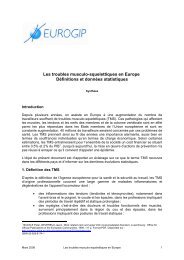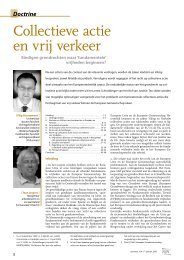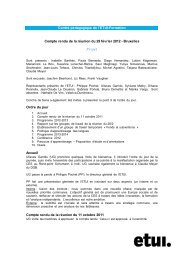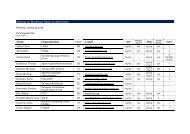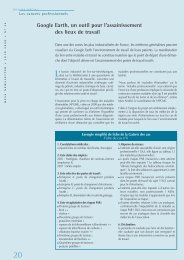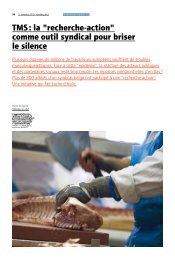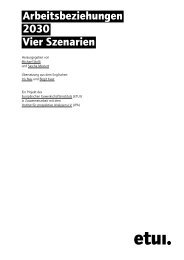Occupation and cancer - European Trade Union Institute (ETUI)
Occupation and cancer - European Trade Union Institute (ETUI)
Occupation and cancer - European Trade Union Institute (ETUI)
You also want an ePaper? Increase the reach of your titles
YUMPU automatically turns print PDFs into web optimized ePapers that Google loves.
Acta Oncol Downloaded from informahealthcare.com by 212.35.100.66 on 04/06/11<br />
For personal use only.<br />
654 E. Pukkala et al.<br />
/ 1000<br />
20<br />
15<br />
10<br />
5<br />
Denmark<br />
Finl<strong>and</strong><br />
Icel<strong>and</strong><br />
Norway<br />
Sweden<br />
0<br />
1960 1970 1980<br />
Year<br />
1990 2000<br />
Figure 8. Infant mortality per 1 000 live births in the Nordic<br />
countries in 1960 2004 [37].<br />
10 years in life expectancy, <strong>and</strong> all other Nordic<br />
populations 5 to 9 years. Icel<strong>and</strong>ic men could expect<br />
to live longer than any other men included in OECD<br />
statistics in 2005. The differences in life expectancy<br />
between the Nordic countries are mostly due to<br />
mortality differences in adult life. Infant mortality in<br />
the Nordic countries is low (Figure 8) [37].<br />
In the Nordic countries, the health service is<br />
financed through taxes or through compulsory<br />
health insurance schemes to a large extent. There<br />
are well-established primary health care systems<br />
<strong>and</strong> well-developed hospital services. Employees on<br />
sick leave either receive their salary or are compensated<br />
by special cash allowances. The self-employed<br />
ensure themselves.<br />
In all of the Nordic countries social assistance is<br />
granted if all other support options have been<br />
exhausted <strong>and</strong> all citizens are guaranteed a certain<br />
level of income at retirement <strong>and</strong> disability [13].<br />
<strong>Occupation</strong>al history of the study population<br />
The population included in the present study was<br />
born between 1896 <strong>and</strong> 1960 (see Materials <strong>and</strong><br />
methods). People in the oldest birth cohorts typically<br />
started working around the age of 15, in the period<br />
between 1910 <strong>and</strong> 1920. Due to the increasing<br />
duration of education, many persons in the youngest<br />
birth cohorts started their working careers around<br />
the age of 25 or even higher. The normal time for<br />
retirement in the Nordic countries has been between<br />
65 <strong>and</strong> 70 years. Thus, persons included in this<br />
study have participated in the labour market from<br />
the years before World War I until after the turn of<br />
the millennium, covering a period of enormous<br />
changes in the types of economic activities <strong>and</strong> the<br />
structure of the labour force in the Nordic countries,<br />
as well as in living <strong>and</strong> working conditions.<br />
%<br />
%<br />
%<br />
40<br />
35<br />
30<br />
25<br />
20<br />
15<br />
10<br />
5<br />
a. Agriculture, forestry, hunting <strong>and</strong> fishing<br />
Denmark<br />
Finl<strong>and</strong><br />
Icel<strong>and</strong><br />
Norway<br />
Sweden<br />
0<br />
1960 1970 1980 1990<br />
Year<br />
1995 2000 2005<br />
40<br />
35<br />
30<br />
25<br />
20<br />
15<br />
10<br />
5<br />
b. Mining, manufacturing, electricity <strong>and</strong> water<br />
Denmark<br />
Finl<strong>and</strong><br />
Icel<strong>and</strong><br />
Norway<br />
Sweden<br />
0<br />
1960 1970 1980 1990<br />
Year<br />
1995 2000 2005<br />
45<br />
40<br />
35<br />
30<br />
25<br />
20<br />
c. Service sector<br />
15<br />
Denmark<br />
10<br />
Finl<strong>and</strong><br />
Icel<strong>and</strong><br />
5<br />
Norway<br />
0<br />
Sweden<br />
1960 1970 1980 1990<br />
Year<br />
1995 2000 2005<br />
Figure 9. Proportion of work force by sector in the Nordic<br />
countries, both genders combined [12,38,39].<br />
One of the main changes has been the decline in<br />
the proportion of the population working in agriculture,<br />
forestry, hunting <strong>and</strong> fishing. In 1900 the<br />
labour force in all the Nordic countries was largely<br />
working in the agricultural sector. The reduction of<br />
workers in agriculture came latest to Finl<strong>and</strong>. As<br />
much as 63% of Finnish men worked in agriculture<br />
in 1930, a much larger proportion than in the<br />
other countries. In 1960 the proportion of persons<br />
(men <strong>and</strong> women combined) in agriculture were




